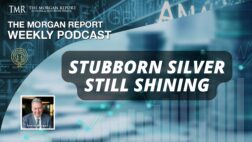by John Lee, CFA (https://twitter.com/johnlee25893955?lang=en)
Roughly 8 months ago in December 2016, I published an article titled “Ride the Vanadium Wave After Lithium”.
In the article, I talked about vanadium redox flow batteries (VRB) which are ideal to store the electricity produced from solar and wind farms that struggle to sell their electricity at times of peak production; and compared to lithium-ion batteries, VRB are non-flammable, environmentally friendly, have estimated lifespans in excess of 10,000 cycles and maintain 90% of their capacity over 20 years.
In 2017, I have written an additional 3 articles about the virtues of vanadium batteries and vanadium’s potential upside for investors.
Today, July 31, the price of vanadium pentoxide (V2O5), which is the proxy for the benchmark price measure for vanadium, reached US$12.4/lb, having more than doubled from US$5/lb at the time when I started covering vanadium 8 months ago. The price is up over 500% since January 2016.

In May Mr. Robert Friedland stated:
“We think there’s a revolution coming in vanadium redox flow batteries,” he says. “You’ll have to get into the mining business and produce ultra-pure vanadium electrolyte for those batteries on a massive scale.
We’re very deeply interested in how you store electrical energy in the grid.
The beauty of the vanadium redox battery is that you can charge and discharge it at the same time, something that can’t be done with a lithium battery. With a vanadium redox flow battery, you can put solar power and wind power into the battery, and you can put excess grid power into the battery at night, and at the same time you can have a stable output into the grid.”
In July at the Natural Resources Forum event at the London Stock Exchange, Robert Friedland was said to be
“in a Vanadium-induced ecstasy. Never could we have imagined the metal having such a euphoric effect. In any case it gave the Friedland imprimatur to a metal which most metals watchers have rarely paid any attention to due to it (largely) being a by-product of other mining and curiously of the petroleum refining industry.
It was not just Friedland though that has latched onto this bandwagon as we have heard vanadium name-checked at a number of recent events recently as the next best thing now that Lithium has somewhat done its dash with promoters overcooking the soufflé.”
The logical question now is: where does vanadium go from here?
Consider the following
Demand Side:
According to Mark Gordon, Senior Resource Analyst, Breakaway Research
“The main use of vanadium is as a steel additive in high-strength steel, which accounts for about 92% of the current global demand of ~100,000t of contained vanadium (~180,000t V2O5 equivalent). The addition of just 0.2% vanadium to steel increases steel strength by up to 100% and reduces weight in relevant applications by up to 30%”.
As buildings are getting taller, the vanadium demand will only increase as China and other developing countries continue to upgrade building safety standards against earthquakes and floods.
Vanadium battery adoption is still in its infancy with less than 500MW (0.5 GW) of installed capacity globally while solar and wind energy combined capacity is at 550GW in 2016, up from 100GW in 2007. There is a lot of pent up demand for VRB, not even counting any future growth of wind and solar capacity.
Supply Side
According to Vanitec (www.vanitec.org), a vanadium industry support organisation,
“Titaniferous magnetite (titanium iron ore) is the most important source for vanadium presently accounting about 85% of the current world V2O5 production.”
I have not come across a credible vanadium analysis of the Chinese market, however based on various sources I gather China accounts for 60% to 80% of world vanadium production. About 20% of the annual Chinese vanadium production, or about 10,000 to 15,000 tonnes of vanadium come as a by-product from small and medium-sized steel mills that are gross air and water polluters with low energy efficiencies and metal recoveries.
Articles at www.asianmetals.com and www.metalbulletin.com attributed the recent vanadium price run up to environmental inspections in China, whereby thousands of tonnes of vanadium supply were removed from the market in July because of facility shut downs or capacity reductions.
I wonder, why do they shut down plants during inspection? Are not inspectors required to collect air samples from chimneys and samples of solid and liquid discharged materials for analysis?
I estimated potentially 10% of global vanadium supply (or 20% of the Chinese vanadium supply) could disappear over the coming months due to permanent plant shut downs. Given the abundance of Chinese vanadium resources, new vanadium production will come on stream however ramp-up could take years considering time for permitting and construction. Suppliers will certainly charge a premium to pay for the new plants that adhere to environmental standards.
Overall, in the short and medium term, I see rising vanadium demand, and flat to possibly declining supply. Throw in a shrewd trader like Glencore plc which controls about 10% of the global vanadium supply, you certainly would not want to be on the short side.
At present time, there is no meaningful or declared vanadium inventory. Vanadium consumers without pre-existing relationship with a bonafide supplier are truly at the mercy of a handful of traders as they scramble for supply at present time at all costs to avoid disruption of their business.
A rising vanadium price makes for increased interest in miners that produce vanadium metal. The only vanadium mining company I know of that’s listed on US or Canadian stock exchanges is Largo Resources Ltd (“Largo”).
Largo’s Maracás Menchen mine is situated on a magnetite (iron ore) deposit. The vanadium grades are high compared to other similar magnetite deposits. However, the operating cost is also high as the vanadium ore (1%) is mixed with high iron (>45%) and other metals. Iron and other metals have to be separated and extracted out by several pyro-metallurgical steps (where vanadium is lost through each step) before the vanadium can be extracted at an overall combined low recovery rate (30% to 40% in our own calculation).

I have written about Largo in my previous articles and avoided owning the stock personally as it had 2 times debt to equity ratio and was a marginal vanadium producer at US$5/lb V2O5. With the current US$10/lb V2O5 price, Largo is a very reasonable speculation with much improved and very attractive reward to risk profile.
Prophecy Development Corp. (TSE: PCY, OTCPK: PRPCF) (“Prophecy”) is the only other vanadium company worth mentioning in my opinion.
Prophecy owns 2 vanadium projects in Canada and 2 in the United States with its flagship Gibellini vanadium project in Nevada.
The Gibellini project is the only North American black shale vanadium project with a full feasibility study. The project is amenable to open pit mining and heap leach processing and has the potential to become the first primary vanadium mine in the United States.
Black shale (also called stone coal) is an important vanadium resource in China. Black shale is regarded as a low-grade multi-element ore. However, because of its relatively high vanadium grade compared to other metallic and nonmetallic elements found in black shale, research and studies of the recovery of vanadium from black shale have received considerable attention and investment in China since early 2000, based on the Prophecy’s research. This has resulted in several black shale vanadium-producing mines in China utilizing established, low cost, solvent extraction and precipitation methods today.
The Gibellini project represents a pure-play vanadium opportunity in North America to investors because Gibellini material is low in deleterious metals and non-metals (typically less than 1% Fe, 0.5% Ca, 0.3% Mg, 0.2% Ti) and is thus conducive to well-established solvent extraction and precipitation methods. Since the process already yields vanadium in sulfuric acid in an intermediary step to producing vanadium pentoxide, it is expected that this intermediary product can be pulled from the process stream and used directly as an electrolyte for grid-scale energy storage batteries.
AMEC E&C Services, Inc. (“AMEC E&C”) prepared the Gibellini Project resource estimate and feasibility study titled “American Vanadium, Gibellini Vanadium Project” having an effective date of August 31, 2011 for American Vanadium Corp. (“AVC”) following the guidelines of the CIM Definition Standards for Mineral Resources and Mineral Reserves. The report which was prepared according to the disclosure requirements of National Instrument 43-101 – Standards of Disclosure for Mineral Projects (“NI 43-101”) outlined 7.9 million tons at a weighted average grade of 0.32% vanadium pentoxide (V2O5) in the measured category and 15.16 million tons at a weighted average grade of 0.28% V2O5 in the indicated category making for a total resource of 23.05 million tons at a weighted average grade of 0.29% V2O5.* Total metal content of the measured and indicated category resources is 131.37 million pounds V2O5. The inferred category resource is 14.23 million tons at a weighted average grade of 0.17% V2O5. The total metal content of the inferred category resource is 49.42 million pounds V2O5.
Based on the feasibility study base case, Prophecy projects mine production to average 11.4 million pounds of vanadium pentoxide per year. Prophecy believes the Gibellini Project could potentially become a low-cost primary vanadium producer based on the low strip ratio of 0.22 and a unit operating cost of US$4.10/lb of vanadium product reported in the feasibility study.
The study’s base case scenario places the Gibellini Project’s after-tax IRR at 43%, and after-tax NPV at US$170.1M at a 7% discount based on capital cost of US$95.5 million and US$10.95/lb vanadium pentoxide price. The vanadium pentoxide price as of today on July 31, 2017 is US$12.48/lb.
*The historic Gibellini mineral resource estimate that was prepared by AMEC E&C for AVC has an effective date of July 31, 2011. Results of the study were disclosed previously by AVC in accordance with NI 43-101 and are considered historic in nature by Prophecy. Mineral resources are reported inclusive of mineral reserves. This historical estimate was prepared using currently accepted methods and assumptions but the costs and prices assumed are not current. It is considered relevant in that the estimate was prepared for the resource area Prophecy intends to lease and acquire and open pit mining was assumed. It is considered reliable since the geologic model developed by AVC geologists was used. This historical estimate assumed open pit mining, on-site processing by heap leach followed by solvent extraction and precipitation, and all services provided by a contract miner. The key parameters for resource estimation included ten foot composites that honoured the domain, grade was interpolated to a distance of 110 ft from the composites, composite grades greater than 1% V2O5 were capped to 1% V2O5 beyond 110 ft, the domain boundaries and a minimum grade of 0.05% V2O5 were used to limit grade interpolation, and a long-term V2O5 price of US$12.59/lb was used. The key methods used include consideration of lithology, alteration and assay results to establish oxidation domains, capping assays and composites as described previously, variography, ordinary kriging, and validations to assess potential bias. The historical estimate uses the same resource classes described in Section 1.2 of NI 43-101. The historical estimate does not include any more recent data or estimates available to Prophecy. The work needed to upgrade the historical estimate as current mineral resources is to use current costs and metal prices. A qualified person has not done sufficient work to classify the historical estimate as current mineral resources. Prophecy is not treating the historical estimate as current mineral resources. Mineral resources that are not mineral reserves do not have demonstrated economic viability.
The Gibellini Project was undergoing the initial stage of the permitting process but was placed on hold by the original owner. The permitting process can be resumed in short order and construction is expected to start in 2019 subject to favorable market conditions and completion of project financing.
Prophecy’s market capitalisation today is Canadian $15 million.
Fundamentals aside, from a contrarian viewpoint, the lack of vanadium coverage by mainstream media (Bloomberg, BNN, CNBC, or even mainstream metals-websites such as www.kitco.com) tells me what we have seen so far ain’t nothing yet compared with what’s to come.
John Lee, CFA.
jlee@prophecydev.com
follow me: twitter https://twitter.com/johnlee25893955?lang=en
linkedin https://ca.linkedin.com/in/john-lee-baa93422

John Lee, CFA is an accredited investor with over 2 decades of investing experience in metals and mining equities. Mr. Lee joined Prophecy Development Corp. (www.prophecydev.com) in 2009 as the Company’s Chairman. Under John Lee’s leadership, Prophecy raised over $100 million through the Toronto Stock Exchange
As full disclosure, I am the Chairman and largest shareholder of Prophecy. The opinions, estimates and projections presented herein are my own and not of Prophecy. This article is not intended to be an offer to sell or a solicitation for an offer to buy securities. Though the sources of information are considered reliable, no representation or warranty, expressed or implied, is made as to the accuracy or completeness of the information contained herein. Neither myself or Prophecy accepts any liability whatsoever for any loss arising from any use of this article or its contents.The technical contents of this article have been reviewed and approved by Christopher M. Kravits, CPG, LPG, General Mining Manager of Prophecy. Mr. Kravits is a Qualified Person as defined in NI 43-101. Mr. Kravits is a consultant to Prophecy, holds no equities in Prophecy and is not independent of Prophecy since most of his income is derived from the Prophecy.



